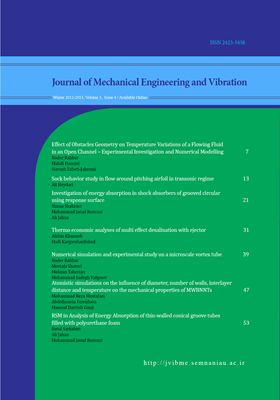-
-
List of Articles
-
Open Access Article
1 - Effect of Obstacles Geometry on Temperature Variations of a Flowing Fluid in an Open Channel – Experimental Investigation and Numerical Modelling
نادر رهبر Mahdi Hamzei Siavash Zabeti-Jahromi -
Open Access Article
2 - Sock behavior study in flow around pitching airfoil in transonic regime
Ali Heydari -
Open Access Article
3 - Investigation of energy absorption in shock absorbers of grooved circular using response surface
شیما شهروی محمد جواد رضوانی علی جهان -
Open Access Article
4 - Modeling of MED distillation with vapor compression
ashkan hamedi Hadi Kargar Sharifabad -
Open Access Article
5 - Numerical simulation and experimental study on a microscale vortex tube
نادر رهبر Mostafa Shateri Mohsan Taherian محمد صادق ولی پور -
Open Access Article
6 - Atomistic simulations on the influence of diameter, number of walls, interlayer distance and temperature on the mechanical properties of MWBNNTs
mohammad reza mostafaei Abdolhosein Fereidoon Masoud Darvish ganji -
Open Access Article
7 - RSM in Analysis of Energy Absorption of thin-walled conical groove tubes filled with polyurethane foam
بتول سرکبیری علی جهان محمد جواد رضوانی
-
The rights to this website are owned by the Raimag Press Management System.
Copyright © 2021-2025







